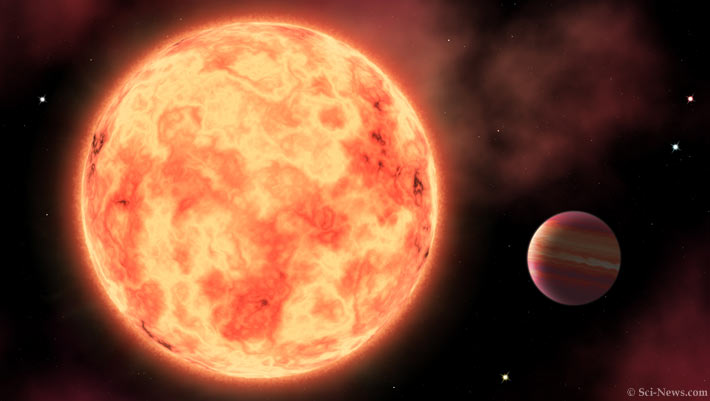The radius of a planet is a fundamental parameter that probes its composition and habitability. Precise radius measurements are typically derived from the fraction of starlight blocked when a planet transits its host star. NASA’s Transiting Exoplanet Survey Satellite (TESS) has discovered hundreds of new exoplanets, but its low angular resolution means that the light from a star hosting a transiting exoplanet can be blended with the light from background stars. If not fully corrected, this extra light can dilute the transit signal and result in a smaller measured planet radius. In an analysis of TESS planet discoveries, astronomers at the University of California, Irvine show that systematically incorrect planet radii are common in the scientific literature.
An artist’s impression of a gas-giant exoplanet and its parent red dwarf star. Image credit: Sci.News.
“We found that hundreds of exoplanets are larger than they appear, and that shifts our understanding of exoplanets on a large scale,” said Te Han, a doctoral student at the University of California, Irvine.
“This means we may have actually found fewer Earth-like planets so far than we thought.”
Astronomers can’t observe exoplanets directly. They have to wait for a planet to pass in front of its host star, and then they measure the very subtle drop in light emanating from a star.
“We’re basically measuring the shadow of the planet,” said University of California, Irvine’s Professor Paul Robertson.
In their research, the authors studied observations of hundreds of exoplanets observed by TESS.
They found that light from neighboring stars can ‘contaminate’ the light of a star an astronomer is studying.
This can make any planet that’s passing in front of a star appear smaller than it truly is, because smaller planets block less light than bigger planets.
The astronomers assembled hundreds of studies describing exoplanets discovered by TESS.
They sorted the planets according to how various research teams measured the radii of exoplanets so they could estimate with the help of a computer model the degree to which those measurements were biased because of light contamination from neighboring stars.
They used observations from ESA’s Gaia satellite to help them estimate just how much light contamination is affecting TESS’ observations.
“TESS data are contaminated, which the custom model corrects better than anyone else in the field,” Professor Robertson said.
“What we find in this study is that these planets may systematically be larger than we initially thought.”
“It raises the question: Just how common are Earth-sized planets?”
The number of exoplanets thought to be similar in size to Earth was already small.
“Of the single-planet systems discovered by TESS so far, only three were thought to be similar to Earth in their composition,” Han said.
“With this new finding, all of them are actually bigger than we thought.”
That means that, rather than being rocky planets like Earth, the planets are more likely so-called water worlds (planets covered by one giant ocean that tend to be larger than Earth) or even larger, gaseous planets like Uranus or Neptune.
This could impact the search for life on distant planets, because while water worlds may harbor life, they may also lack the same kinds of features that help life flourish on planets like Earth.
“This has important implications for our understanding of exoplanets, including among other things prioritization for follow-up observations with the NASA/ESA/CSA James Webb Space Telescope, and the controversial existence of a galactic population of water worlds,” Professor Roberston said.
The study was published in the Astrophysical Journal Letters.
_____
Te Han et al. 2025. Hundreds of TESS Exoplanets Might Be Larger than We Thought. ApJL 988, L4; doi: 10.3847/2041-8213/ade794
